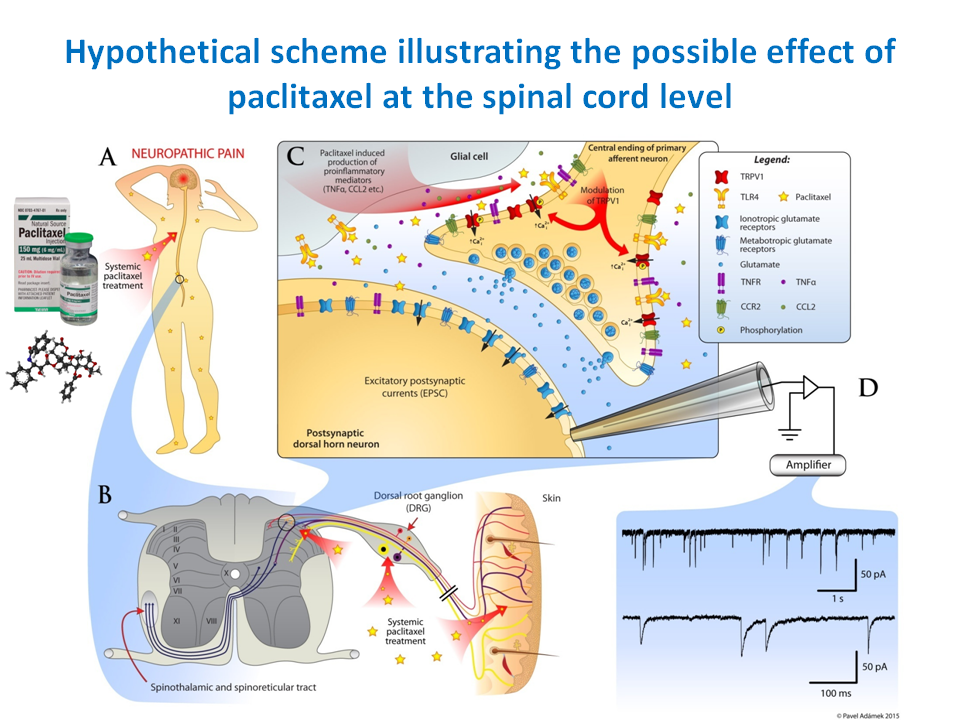Scientists from the Department of Functional Morphology in collaboration with colleagues from The University of Texas showed that paclitaxel induced pain is mediated by TRPV1 and TLR4 receptors.
Paclitaxel is widely used in the clinical practice as chemotherapeutic drug to treat several types of malignant tumours, but the treatment is frequently accompanied with development of persistent painful peripheral neuropathy. This type of pain is often resistant to standard analgesics and often leads to termination of the antitumor therapy. In our study we tested hypothesis that these neuropathic pain adverse effects could be partially mediated due to activation of Toll-like 4 (TLR4) and Transient Receptor Potential Vanilloid 1 (TRPV1) receptors at the spinal cord level. Our experiments demonstrated that paclitaxel induced increase of glutamate release and frequency of mEPSC (miniature excitatory post-synaptic currents) at the spinal cord level is dependent on TRPV1 receptor activation. Paclitaxel application also induced robust change in activation of spinal TRPV1 receptors, tested by application of their agonist, capsaicin. This effect of paclitaxel was prevented by TLR4 antagonist LPS-RS. Our collaborators, the team of Prof. Dougherthy from The University of Texas M.D. Anderson Cancer Center (Houston, Texas), also demonstrated that similar mechanisms of TRPV1 receptors activation are present in human dorsal root ganglion neurons.
Our experiments demonstrated that functional interaction between TLR4 and TRPV1 receptors may play an important role in modulation of nociceptive synaptic transmission in the spinal cord after paclitaxel treatment. Understanding these mechanisms is needed to improve treatment of the chemotherapy-induced neuropathic pain. These results were published in the September issue of The Journal of Neuroscience.
Fig. 1. Schematic drawing of paclitaxel effect at spinal cord level. (A) Paclitaxel after systemic treatment may modulate properties of peripheral nerves. However, low concentration of paclitaxel penetrates through hematoencephalic-barrier to the central nervous system (B). In the spinal cord paclitaxel may activate TLR4 receptors and modulate release of neurotransmitters from presynaptic endings by modulation of TRPV1 receptors function (C). These changes are studied by whole-cell patch clamp recoprdings from spinal cord dorsal horn neuronas, as changes in excitatory postsynaptic currents (D).
Li Y, Adamek P, Zhang H, Tatsui C, Rhines L, Li Q, Mrozkova P, Zhang H, Kosturakis A, Cassidy R, Cata J, Sapire K, Harrison D, Kennarmer-Chapman R, Jawad A, Ghetti A, Yan J, Palecek J, and Dougherty P. J., The cancer chemotherapeutic paclitaxel increases human and rodent sensory neuron responses to TRPV1 by activation of TLR4, J. Neurosci, 2015, IF=6,3
Kalynovska, Nataliia – Diallo, Mickael – Sotakova-Kasparova, Dita – Palecek, Jiri. Losartan attenuates neuroinflammation and neuropathic pain in paclitaxel-induced peripheral neuropathy. J Cell Mol Med. 2020;24:7949–7958.
Adámek, Pavel – Heleš, Mário – Paleček, Jiří . Mechanical allodynia and enhanced responses to capsaicin are mediated by PI3K in a paclitaxel model of peripheral neuropathy . Neuropharmacology 2019, 146(Mar 1), 163-174 . IF = 4.431
Kalynovska, Nataliia – Adámek, Pavel – Paleček, Jiří . TRPV1 receptors contribute to mediate paclitaxel-induced c-Fos expression in spinal cord dorsal horn neurons . Physiological Research. 2017, roč. 66, 3, p. 549-532 . IF = 1.324











